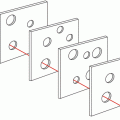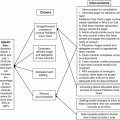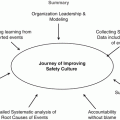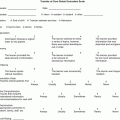Fig. 4.1
QI team members should include all members throughout the spectrum of the care process and allow for facile communication between all members. *Additional staff: advanced practice providers, pharmacists, laboratory, interpreters, social work, child life, paramedics, environmental services, engineering, etc
An alternative structure for team formation in healthcare quality improvement shares some characteristics with the above-proposed composition but may be more comprehensive with respect to the ultimate goal of successful improvement project implementation in an organization. This relatively simple yet effective project team structure proposed by healthcare quality improvement pioneer Brent James has proved successful in practical experience for many [6]. He identifies three major roles within teams: team members, team leader, and team facilitator (Fig. 4.2). First, team members should be drawn from the frontlines of the work process that is trying to be improved. These individuals have fundamental knowledge of the process and understand the intricacies of how work gets done on a day-to-day basis. And as Deming said, in quality improvement, we ought to “organize everything around value-added high-priority work processes” [7]. In addition to providing that fundamental knowledge, a key role of these team members is to communicate the team’s output back to their non-team member frontline counterparts. The advantage of this structure is that a peer is keeping the frontline informed about the decisions being made by the team and they can solicit further feedback or refinements from other frontline staff engaged in a similar part of the process throughout the project. This approach makes a critical difference when implementing or scaling efforts. Given these responsibilities, identifying frontline staff up with robust leadership and organizational skills is critical.


Fig. 4.2
Brent James’ teams model. Adapted with permission from Dr. Brent James, Intermountain Healthcare, Institute for Healthcare Delivery Research, 2009
In James’ model, an improvement team should also have a team leader. Often this individual may be a member of a guidance or more senior management team. They typically set the agenda, record team activities, and report back to senior leadership or executive sponsors. Similar to how the frontline team members communicate back to their frontline peers, team leaders should communicate with their management peers to keep them informed of the project and solicit feedback from the beginning. As a result, when the team presents their final recommendations, senior leadership can implement their findings quickly and effectively with little resistance or rework required from the team. James goes as far to say that senior management has a duty to implement the teams’ recommendations “as is” since they have been kept informed of the teams’ activities and had plenty of opportunity to offer feedback or constructive critique. Though some may disagree, Dr. James also makes the point that record keeping and the details of the team’s output should be performed by the team leader (not delegated to another individual on the team or to administrative support), as ultimately in this structure, the team leader needs to be able to accurately and fully communicate the team findings throughout the process to senior leadership.
The final role in the basic structure of an improvement team is that of a QI facilitator. Not all teams need a facilitator but it can be helpful in many situations. The role of the facilitator according to James is primarily to keep the team “healthy” rather than attempt to improve the actual problem the team has been assigned. It is the facilitator’s responsibility to ensure the team is healthy enough to focus on truly following through on the specific aim the team is committed to improving. Team health can be defined in terms of the components listed under the team dynamics section below that define an effective team—safety, inclusivity, openness, and consensus-seeking. One approach to facilitate this is to establish “ground rules” from the start of how team members will conduct themselves in their interactions inside and outside of the team. For example, a team may choose upfront that once they have achieved consensus that the team speaks with “one voice” to others outside of the team. Similarly, if team members don’t voice dissent, this is will be considered akin to assent. Additionally, the facilitator also should have expertise in the QI tools described above and can assist the team leader and the group in the application of formal QI concepts.
Stages of Team Formation
The development of teams focused on implementation and continuous evaluation of strategy within and external to the team can improve the overall outcome of the results [8]. Although teams were once considered to be static in nature, as goals are defined and projects evaluated with time, they can be dynamic, reflecting changes in resources and priorities [9, 10]. One cannot expect a team to work optimally when it first comes together. Forming a successful team takes time to allow members to progress through a series of well-characterized stages. The model described by Bruce Tuckerman in 1965 established a theory of group dynamics that can be integral to understanding these stages of team development. There are four recognizable stages: forming, storming, norming, and performing [11] (Table 4.1). As a group is formed, team members will act independently, will be motivated, and will act politely and courteously toward others. However, as the team may not be informed of the goals and objectives, some individuals may also be anxious and fearful. As the team progresses, the next stage of storming may develop; other teams may progress to norming without this stage. While in the storming stage, members feel compelled to voice their opinions, which may be positive or negative, pushing against the boundaries and resisting quality improvement strategies proposed by other members. During this stage, it can be difficult to move toward the group’s goals, but with time and strong leadership, one can move to the next phase of norming. In this stage, individuals start to resolve their differences, appreciate the input and skills of their colleagues, as well as respect leadership. At this time, team members know one another, are able to socialize, ask for help, and provide constructive criticism leading to a stronger team and progress toward the goal. As norming is established, a team’s hard work without friction leads to the performing stage and, in turn, achievement of the team’s goals. It is important to consider these stages as a team is being established, as recognition of the stage of a team can allow for knowledge as to how the team may progress especially from storming to norming, allowing time for the dynamics to develop through the stage without failures and dissolution of the team.
Table 4.1
Bruce W. Tuckman’s stages of team development
Stage | |
|---|---|
Forming | The team is developing and learning about goals and direction usually with excitement and eagerness. As this stage is focused on direction primarily by the team leader, goal setting productivity may be low |
Storming | Team members’ excitement wanes; they push the boundaries of others with frustrations, conflicts, and disagreements |
Norming | Although there are differences among team members, these differences are accepted with the ability to move on as a team |
Performing | The team now has a shared vision and goal, and individuals have more autonomy in decision-making |
Although it is important to consider internal team dynamics for successful progress toward a goal, several recent studies have shown that how much a team’s members interact with individuals outside the team boundaries can also be an important factor in team performance [12]. Other members outside a team can influence the behaviors, expectations, and motivations that team members bring back to the group and thus should be given appropriate consideration [11].
Team Dynamics
After successful development of a team, how individuals work within the team is integral to obtaining the desired outcome. Dr. Brent James again has identified a number of features of effective QI teams [6]. He asserts that teams do not just happen but rather require thoughtful planning, leadership, and organization. He draws in part from work written about communities by psychiatrist and author M. Scott Peck to note four qualities of effective teams: safety, inclusivity, openness, and consensus-seeking. Safety means that members are free to offer ideas without personal attack. Ideas stand on their own; critique of an idea is not a personal attack on the individual it came from, and future ideas should not be judged within the context of prior ideas. Inclusivity means examining ideas from different viewpoints. If current team members do not have the relevant fundamental knowledge for a particular aspect of the project, the team should be dynamic enough to bring the appropriate experts into the team on an ad hoc basis. A related concept is that of groupthink, popularized in the 1970s by social psychologist Irving Janis in his discussion of foreign policy as cited by Hart [13]. In this psychosocial phenomenon, dissenting opinions are ostracized, and group members shun confrontation or personal doubts which leads to a distorted view of reality, unjustified optimism, and ultimately poor decisions. Many involved in teams (including these authors) have discovered that one way to curtail this is for a group leader to intentionally and explicitly raise counterpoints or alternative strategies for the purposes of holistic discussion. The feature of openness refers to counteracting hierarchy or dominance based on authority within a group. Finally, James notes that if the aforementioned are present, consensus-seeking, the final characteristic, can occur. Consensus-seeking is a fundamental tenet of teams, and it is this characteristic that truly differentiates teams from other group structures. Dr. James defines consensus as finding a solution that is acceptable enough that all members can support it and that no member opposes it. He adds that consensus is neither a unanimous opinion nor a majority vote and does not mean that everyone is completely satisfied. That said, once consensus is reached, all team members should support it, particularly in interactions outside of the team.
Ungerleider and Ungerleider, leaders in team dynamics in healthcare and in particular the complex setting of pediatric cardiac care, have described another set of related but more specific features of team dynamics they have identified as the “Seven Practices of the Highly Resonant Teams” [14]. They argue that attention to the intra- and interpersonal factors that create teamwork can result in substantial improvements in quality and outcomes. They remind us that medical knowledge, skills, and judgement alone are likely not enough to achieve high standards of quality and safety in healthcare. These seven practices are built upon a foundation of psychological safety—a space free of judgment, ridicule, and blame as well as attunement, a reflective quality described as mindful sensitivity for the individual’s self, for others on the team, and for the context of the present situation. Mindful integration focuses on the ability to manage one’s own needs and the needs of others within the context and demands of the team. This awareness and ability to manage self, others, and the current situation or environment has also been described as emotional intelligence. Mindfully integrated communication requires that team members are consistently aware of the competing demands of these three elements and find a way to nonjudgmentally value each or risk creating one of several negative cultures depending on which is discounted. The second feature of highly resonant teams is that teams must invite learning. The ability to create an environment where it is safe to struggle and learn from failures, where failures are viewed as opportunities to explore and discover rather than being ashamed of, increases the chances of identifying new solutions. Challenging team members to learn and ask questions, even when the answers are not immediately apparent, is part of this element of high resonance teams. The third principle, referred to as the push-up button, stresses the importance creating team environments that promote positivity. They cite recent research on creating teams indicating that how we communicate is far more important than what we communicate. For example, several studies reveal that high-performing teams have a greater amount of positive compared to negative elements and emotions because negativity can have a more powerful influence than positivity, and therefore it takes more positivity to counterbalance the negative. Although there has to be space for conflict and imperfection, the elevation and support among team members must outweigh this for continued success. Creating systems with outcomes in mind is the fourth principle that includes creating systems for establishing psychological safety. Teams that demonstrate this fourth practice also need to have clarity surrounding the outcomes that they desire including identifying the drivers of those outcomes. The fifth principle focuses on the ability to be flexible and stable. Though at first glance these two features may seem mutually exclusive, they are not and rather are requisites for healthy team growth. Resonant teams strive toward a balanced approach to rules. When a team can identify their core values and principles, they can then transform their rules into guidelines but then simultaneously understand the exceptions to their rules that can “create energy and growth, consistency without rigidity, flexibility with stability.” The sixth principle is centered upon shared accountability. This practice promotes acceptance of an outcome and recognition that it belongs to the entire time—the team wins and loses together. Lastly, the seventh principle of highly resonant teams encourages team members to speak up by being a good upstander when they see other members being treated unfairly. This is particularly relevant for teams improving patient safety in that concerns are taken seriously and evaluated objectively, regardless of the “role” of the person on the team (Table 4.2).
Table 4.2




Seven practices of highly resonant teams
Stay updated, free articles. Join our Telegram channel

Full access? Get Clinical Tree








